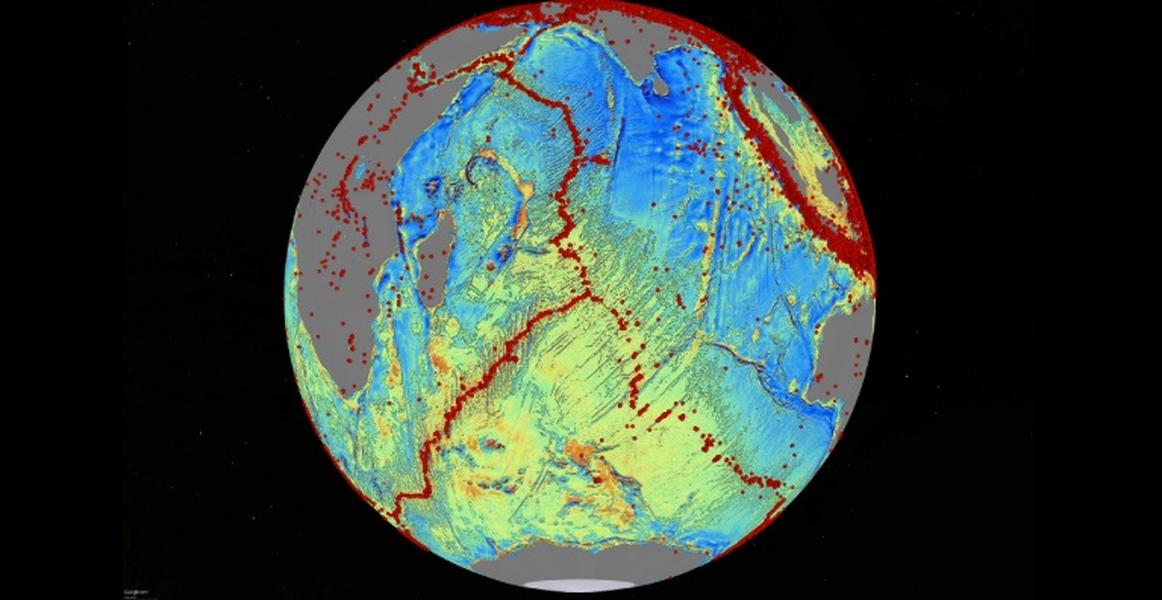Using new map of the ocean floor, scientists discover underwater mountains and volcanoes


More mysteries of the deep have been solved, thanks to the highest resolution map yet of the ocean floor.
The map has revealed thousands of underwater ranges and extinct volcanoes that scientists previously did not know about, the Los Angeles Times reports. While still extremely low resolution, the new map is at least twice as accurate as the last version, put together about two decades ago.
The study, published Thursday in Science, made two big discoveries: a range in the South Atlantic nearly 500 miles long, and a ridge in the Gulf of Mexico as wide as Texas. David Sandwell, geophysics professor at Scripps Institute of Oceanography at UC San Diego, led the study. So little is known about the deep-sea floor that it's almost like a completely different planet that was only recently explored for the first time, he told the Times. "We have maps of Mars that have 100 to 10,000 times more resolution than maps of the deep ocean."
The Week
Escape your echo chamber. Get the facts behind the news, plus analysis from multiple perspectives.

Sign up for The Week's Free Newsletters
From our morning news briefing to a weekly Good News Newsletter, get the best of The Week delivered directly to your inbox.
From our morning news briefing to a weekly Good News Newsletter, get the best of The Week delivered directly to your inbox.
The map was created by using data collected by the European Space Agency's CryoSat-2 and Jason-1, operated by NASA and CNES, the French space agency. The spacecraft have instruments able to measure topography of the ocean surface within a fraction of an inch. Ships are capable of carrying instruments that could get better images, but such a survey would cost too much, requiring 10 ships in order for the survey to be done in a decade.
Sandwell admits the resolution of the map "is still pretty terrible," but he's pleased with the image. "It's better than what we had before."
A free daily email with the biggest news stories of the day – and the best features from TheWeek.com
Catherine Garcia has worked as a senior writer at The Week since 2014. Her writing and reporting have appeared in Entertainment Weekly, The New York Times, Wirecutter, NBC News and "The Book of Jezebel," among others. She's a graduate of the University of Redlands and the Columbia University Graduate School of Journalism.
-
 Trump vs. states: Who gets to regulate AI?
Trump vs. states: Who gets to regulate AI?Feature Trump launched a task force to challenge state laws on artificial intelligence, but regulation of the technology is under unclear jurisdiction
-
 Decking the halls
Decking the hallsFeature Americans’ love of holiday decorations has turned Christmas from a humble affair to a sparkly spectacle.
-
 Whiskey tariffs cause major problems for American distillers
Whiskey tariffs cause major problems for American distillersIn the Spotlight Jim Beam is the latest brand to feel the pain
-
 Blue Origin launches Mars probes in NASA debut
Blue Origin launches Mars probes in NASA debutSpeed Read The New Glenn rocket is carrying small twin spacecraft toward Mars as part of NASA’s Escapade mission
-
 Dinosaurs were thriving before asteroid, study finds
Dinosaurs were thriving before asteroid, study findsSpeed Read The dinosaurs would not have gone extinct if not for the asteroid
-
 SpaceX breaks Starship losing streak in 10th test
SpaceX breaks Starship losing streak in 10th testspeed read The Starship rocket's test flight was largely successful, deploying eight dummy satellites during its hour in space
-
 Rabbits with 'horns' sighted across Colorado
Rabbits with 'horns' sighted across Coloradospeed read These creatures are infected with the 'mostly harmless' Shope papilloma virus
-
 Lithium shows promise in Alzheimer's study
Lithium shows promise in Alzheimer's studySpeed Read Potential new treatments could use small amounts of the common metal
-
 Scientists discover cause of massive sea star die-off
Scientists discover cause of massive sea star die-offSpeed Read A bacteria related to cholera has been found responsible for the deaths of more than 5 billion sea stars
-
 'Thriving' ecosystem found 30,000 feet undersea
'Thriving' ecosystem found 30,000 feet underseaSpeed Read Researchers discovered communities of creatures living in frigid, pitch-black waters under high pressure
-
 New York plans first nuclear plant in 36 years
New York plans first nuclear plant in 36 yearsSpeed Read The plant, to be constructed somewhere in upstate New York, will produce enough energy to power a million homes
